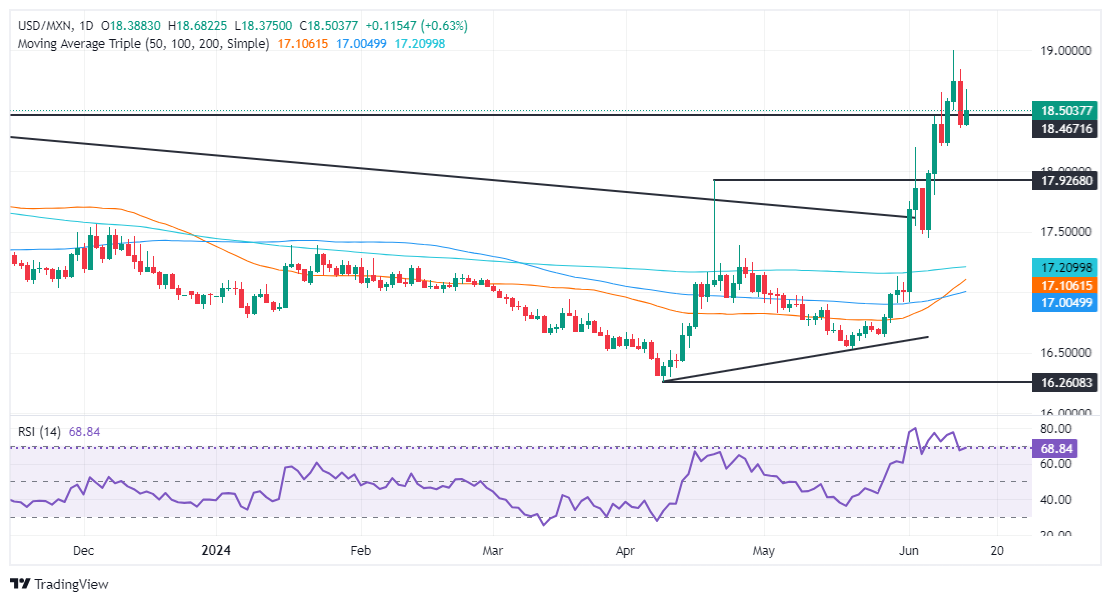Mexican Peso sinks as post-election losses pile up, down 0.30% in the week

- Mexican Peso down as judiciary reform fears continue to weigh on investor sentiment.
- Presumptive President Claudia Sheinbaum reassures investors but echoes President AMLO’s proposal for elected judges.
- Banxico ready to act against volatility, while Fed’s unchanged rate decision and consumer sentiment data bolster USD/MXN.
The Mexican Peso’s downtrend continued Friday, with the emerging market currency depreciating by 0.48% as market participants were still nervous about the judiciary reform. Presumptive President Claudia Sheinbaum reiterated Thursday that the reform is a go, emphasizing that judges should be elected, agreeing with President Andres Manuel Lopez Obrador’s proposal. Therefore, the Peso continues to weaken, and the USD/MXN trades at 18.44.
Mexico’s presumptive President Claudia Sheinbaum reassured investors that they shouldn’t be concerned about the reforms. She said, “Mexico’s economy is healthy, strong, and [there is] nothing to worry about.”
Meanwhile, Bank of Mexico (Banxico) Governor Victoria Rodriguez Ceja said on Wednesday that the central bank is attentive to volatility in the Mexican currency exchange rate and could act to restore “order” in markets.
Across the border, the latest Federal Reserve (Fed) decision to keep rates unchanged and projection of just one interest rate cut in 2024 cushioned the Greenback and boosted the USD/MXN to 14-month highs.
A survey by the University of Michigan (UoM) showed that consumer sentiment amongst Americans deteriorated further, blamed on inflation and incomers. Joanne Hsu, the Director of the Consumers Survey, said that “Assessments of personal finances dipped, due to modestly rising concerns over high prices as well as weakening incomes. Overall consumers perceive few changes in the economy from May.”
Daily digest market movers: Mexican Peso trims some of Thursday’s gains
- In February 2024, AMLO put forward several proposals to the Mexican Congress. These include a Supreme Court reform that suggests electing Supreme Court ministers through popular vote; an electoral reform aimed at electing electoral commission councilors by popular vote and reducing multi-member representation; and a reform of autonomous bodies that proposes dissolving the transparency body.
- Mexican Peso depreciation could weigh on Banxico decision to ease policy on June 27 despite last month’s dip in core prices. Therefore, keeping interest rates higher could prompt deceleration in the economy and increase the odds of a possible recession.
- Mexico’s economic docket for next week will feature Aggregate Demand, Private Spending, and Retail Sales data. Despite that, the USD/MXN exchange rate continues to be driven by political uncertainty about the changes to the Mexican Constitution that threaten the state of law.
- Morgan Stanley noted that if Mexico’s upcoming government and Congress adopted an unorthodox agenda, it would undermine Mexican institutions and be bearish for the Mexican Peso, which could weaken to 19.20.
- The UoM Consumer Sentiment Index in June fell to 65.6 from 69.1 and missed the consensus of 72. Sentiment dropped to its lowest level in seven months. Inflation expectations for the next twelve months are expected to remain at 3.3%, unchanged, and for a five-year period, they are foreseen at 3.1%, down from 3.3%.
- Latest US inflation report increased the odds of a Fed rate cut in September from 46.7% to 62%, according to CME FedWatch Tool.
- December’s 2024 fed funds futures contract hints that investors expect 39 basis points of rate cuts by the Fed through the end of the year.
Technical analysis: Mexican Peso prints losses as USD/MXN slides below 18.50
The USD/MXN pair is upwardly biased despite retreating below 18.50. Although momentum is tilted in the seller’s favor, according to the Relative Strength Index (RSI), they need to push the USD/MXN exchange rate below the April 19 high of 18.15 if they would like to keep the exotic pair trading within the 18.00-18.15 range.
On the buyer’s side, if USD/MXN breaches 18.50, the next resistance level would be the year-to-date high of 18.99, followed by March 20, 2023, high of 19.23. A breach of the latter will sponsor an uptick to 19.50, ahead of the psychological 20.00 mark.
Mexican Peso FAQs
The Mexican Peso (MXN) is the most traded currency among its Latin American peers. Its value is broadly determined by the performance of the Mexican economy, the country’s central bank’s policy, the amount of foreign investment in the country and even the levels of remittances sent by Mexicans who live abroad, particularly in the United States. Geopolitical trends can also move MXN: for example, the process of nearshoring – or the decision by some firms to relocate manufacturing capacity and supply chains closer to their home countries – is also seen as a catalyst for the Mexican currency as the country is considered a key manufacturing hub in the American continent. Another catalyst for MXN is Oil prices as Mexico is a key exporter of the commodity.
The main objective of Mexico’s central bank, also known as Banxico, is to maintain inflation at low and stable levels (at or close to its target of 3%, the midpoint in a tolerance band of between 2% and 4%). To this end, the bank sets an appropriate level of interest rates. When inflation is too high, Banxico will attempt to tame it by raising interest rates, making it more expensive for households and businesses to borrow money, thus cooling demand and the overall economy. Higher interest rates are generally positive for the Mexican Peso (MXN) as they lead to higher yields, making the country a more attractive place for investors. On the contrary, lower interest rates tend to weaken MXN.
Macroeconomic data releases are key to assess the state of the economy and can have an impact on the Mexican Peso (MXN) valuation. A strong Mexican economy, based on high economic growth, low unemployment and high confidence is good for MXN. Not only does it attract more foreign investment but it may encourage the Bank of Mexico (Banxico) to increase interest rates, particularly if this strength comes together with elevated inflation. However, if economic data is weak, MXN is likely to depreciate.
As an emerging-market currency, the Mexican Peso (MXN) tends to strive during risk-on periods, or when investors perceive that broader market risks are low and thus are eager to engage with investments that carry a higher risk. Conversely, MXN tends to weaken at times of market turbulence or economic uncertainty as investors tend to sell higher-risk assets and flee to the more-stable safe havens.
Information on these pages contains forward-looking statements that involve risks and uncertainties. Markets and instruments profiled on this page are for informational purposes only and should not in any way come across as a recommendation to buy or sell in these assets. You should do your own thorough research before making any investment decisions. FXStreet does not in any way guarantee that this information is free from mistakes, errors, or material misstatements. It also does not guarantee that this information is of a timely nature. Investing in Open Markets involves a great deal of risk, including the loss of all or a portion of your investment, as well as emotional distress. All risks, losses and costs associated with investing, including total loss of principal, are your responsibility. The views and opinions expressed in this article are those of the authors and do not necessarily reflect the official policy or position of FXStreet nor its advertisers. The author will not be held responsible for information that is found at the end of links posted on this page.
If not otherwise explicitly mentioned in the body of the article, at the time of writing, the author has no position in any stock mentioned in this article and no business relationship with any company mentioned. The author has not received compensation for writing this article, other than from FXStreet.
FXStreet and the author do not provide personalized recommendations. The author makes no representations as to the accuracy, completeness, or suitability of this information. FXStreet and the author will not be liable for any errors, omissions or any losses, injuries or damages arising from this information and its display or use. Errors and omissions excepted.
The author and FXStreet are not registered investment advisors and nothing in this article is intended to be investment advice.





